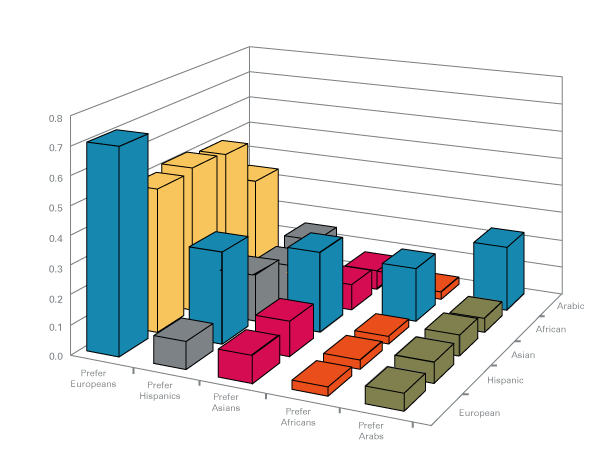The authors analyse anonymous profile and preference information of users registered at the eDarling online dating site. In an agreement with the company, data were accessed for all users in September 2011, resulting in a total pooled sample of 58,880 heterosexual members. The focus relies on initial profile information, and more precisely the selection criteria that users impose in terms of race, as well as their socio-demographic data records when they first fill out their profile. Irrespective of birthplace, the data were grouped into five mutually exclusive categories, which refer to the majority population of Europeans (the ‘native’ Caucasian population) and four minority racial groups of non-European origin (Hispanic, Arabic, African and Asian).
Online dating is one of the fastest growing ways in which individuals in many countries meet a partner. Therefore, it can serve as an immediate gauge of wider race relations and integration in a country. However, at this point in time, this has hardly been scientifically explored outside of the United States, nor from a comparative perspective. Potârcă and Mills contribute to the field by examining the level of in- and out-group preferences in online dating across nine European countries.
The hierarchy of popularity in different countries
Figure 1 shows that daters tend to prefer partners with the same racial background. Europeans are the most preferred group and generally less willing to be matched with those from other races. Data also shows that after Europeans and own group (i.e. same racial background), Hispanics and Asians hold intermediate rankings, and Arabs and Africans are the least preferred.

Figure 1: Predicted probabilities of preferences for specific groups, by own race (n=58,880).Figure 1: Predicted probabilities of preferences for specific groups, by own race (n=58,880).
Notes: Numbers are based on a multivariate logistic regression model, controlling for education, gender, age, religion, marital history, importance of partner's race, long-term dating intentions, type of membership, and country. Patterned columns across the diagonal indicate same-race preferences.
Source: Potârcă and Mills, 2015.
Although racial hierarchies are consistent across all countries, differences are also found due to distinct immigrant populations, anti-immigrant climate, or citizenship and civic integration regimes. Italy, France and Austria have the highest same-race preferences among Europeans, whereas Sweden scores the lowest. Minority members generally display the highest in-group preferences in the Netherlands and France. In Switzerland, minority members, particularly Hispanics and Asians, appear to have the highest probabilities of preferring Europeans. Also in Switzerland, Europeans have the highest probabilities of preferring minority members. The lowest probabilities of preferring Europeans among minority racial groups are in Poland. Finally, the native Polish, Spanish, and Italians are the least willing to date minority members.
The preferences of the majority groups
Increases in the share of the foreign-born group are related to both a decrease in the Europeans’ in-group preferences and also a systematic increase in their out-group preferences. The authors identified two extremes: Switzerland, with a large foreign-born group and high preferences for minorities among Europeans, and Poland, with a small fraction of the foreign-born population and a corresponding low preference for minorities among the majority group.
In countries with strongly inclusive policies such as Sweden, the European majority has the lowest probability of same-race preferences. However, when looking at specific preferences for minorities among the native population, the high degree of inclusiveness in Sweden is only associated with moderate preference levels for Hispanics, Asians and Africans, and low preferences for Arabs. Furthermore, despite their more restrictive integration policies, the Swiss context is consistently related to high levels of preferences for minority groups among Europeans. Therefore, for the majority group, geographical proximity and familiarity with out-groups play a considerable role in alleviating racial divides in romantic relationships.
The preferences of minority groups
Turning to the specific patterns of racial preferences among minority groups, those belonging to larger groups, such as Africans and Arabs in France, have higher same-race preferences. Contrary to expectations, the increase in relative group size at the country level is also linked to higher probabilities of preferring Europeans among minorities, particularly for Hispanics in Spain, Asians in Switzerland, and Africans living in France or Switzerland. For Arabs residing in France, however, a larger group size is associated with a rather low probability of preferring majority members.
In sum, across all contexts, a clear hierarchy of racial preferences emerged, ranking Europeans and one’s own group on top, Hispanics and Asians in an intermediate position, followed by Africans and Arabs. Social distances are perpetuated by native Europeans but also racial minority groups, which in the need to distinguish themselves from similarly low-ranked groups paradoxically concede to a biased hierarchy of out-groups. Results demonstrate that Internet dating allows an efficient selection by racial divisions, while perpetuating country-specific racial inequalities.

*This PopDigest has received funding from the European Union's Seventh Framework Programme (FP7/2007-2013) under grant agreement n° 320116 for the research project FamiliesAndSocieties.
FamiliesAndSocieties (www.familiesandsocieties.eu) has the aim to investigate the diversity of family forms, relationships and life courses in Europe, to assess the compatibility of existing policies with these changes, and to contribute to evidence-based policy-making. The consortium brings together 25 leading universities and research institutes in 15 European countries and three transnational civil society organizations.